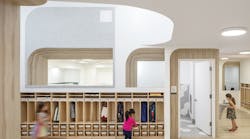RGB – the magic formula in terms of acceptance
One notable development is that in advertising 10 per cent of neon lighting has already been replaced by LEDs. Applications in building exterior lighting and for ambient lighting in bars and wellness facilities are attracting particular attention, and arousing people’s curiosity about the durable little magic lamps. That is especially true when LEDs are deployed over large surface areas, and not just as spotlighting.
Dragging other forms of lighting along in its wake
Advances in LEDs are also resulting in improvements to conventional forms of lighting in terms of energy-saving and service lifetime. Dr. Ziemssen expects to see an upgrade in service life specifications for fluorescent lamps in particular – as a response to their impending substitution by LEDs.
One example: The corporate design colour of a chain of stores is red, and the management is looking to display a wide array of different light density effects on 1.5 m2 surface area in its branches. Such a lighting effect could be realised with white fluorescent lamps and colour filter transparencies. The cost would be cheaper than a variant employing red LEDs. However, the installation would need 35 Watts of power, and would also lose part of its energy through the colour filters.
A solution with LEDs would need just 6 Watts of power to create a comparable effect, and would utilise that power in full. So in order to select the truly more cost-effective solution, it is not only a question of comparing the purchase cost, but also the savings to be gained over the years resulting from the lower power consumption of LEDs and from the lower maintenance costs incurred by virtue of their long lives. Consequently, the difference in purchase price would be very quickly amortised.
New markets based on intelligent light
Homework for LED developers
The energy-saving potential and special qualities of LED light are the main factors driving the bright future promise of LEDs. However, the experts agree that LED developers still face a number of challenges: The current white-quality of LEDs and optics needs to be improved; electronic ballasts need to be miniaturised; control systems need to deliver more features, and their communication with the LED modules needs a standard. The standardisation of control system communications and of output voltages is vital, and will open up new markets to LEDs.
Such improvements are essential even though global developments are advancing at a different pace – with a much greater readiness to make the move to LED technology in Asia than in Europe for example. In the USA, too, LEDs will become established more quickly, because power consumption is very high, though outages often occur.
Even with regard to the film and television studios in Hollywood, for example, it is clear to see that the potential savings from using LEDs are enormous. Another factor is that LEDs discharge less heat, so air conditioning costs can also be saved. Moreover, the brightness variation and colour changing properties of LEDs enable many more effects and moods to be achieved, which can only be of benefit to the future generations of dream factory blockbusters.
This represents a typical example of how LEDs – provided they are applied correctly, with intelligent control and good thermal management – are creating many advantages which are gradually being widely recognised and utilised.
++++++++++++++++++
This article is an extract of The Quintessence, a new know-how magazine that tells you all you want to know about the special features of LED technology.
Get your free copy today at www.ebv.com/thequintessence.
Highlights of the first issue include applications demonstrating the design scope offered by LEDs, such as the impressive lighting concept for the Torre Agbar in Barcelona and the fascinating use of LEDs by light designer Ingo Maurer.














